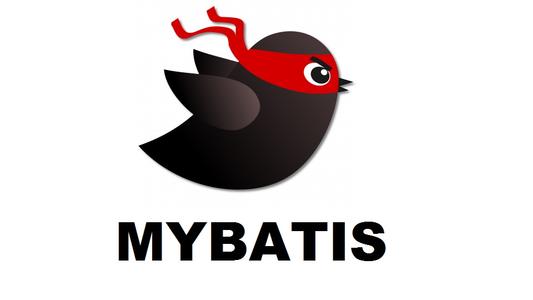一、Mybatis 的接口层
1.SqlSession
sqlSession总结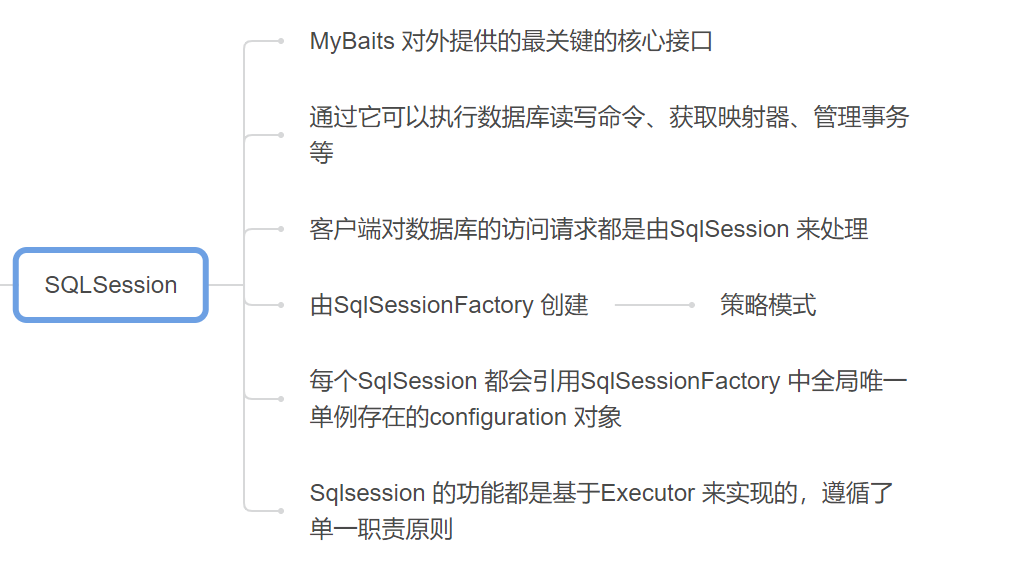
"图1"
总之一句话:
/**
* The primary Java interface for working with MyBatis.
* Through this interface you can execute commands, get mappers and manage transactions.
*
* @author Clinton Begin
*/翻译过来,就是:对外访问统一的接口,通过这些接口,完成读写命令,获取映射和管理事务。
UML: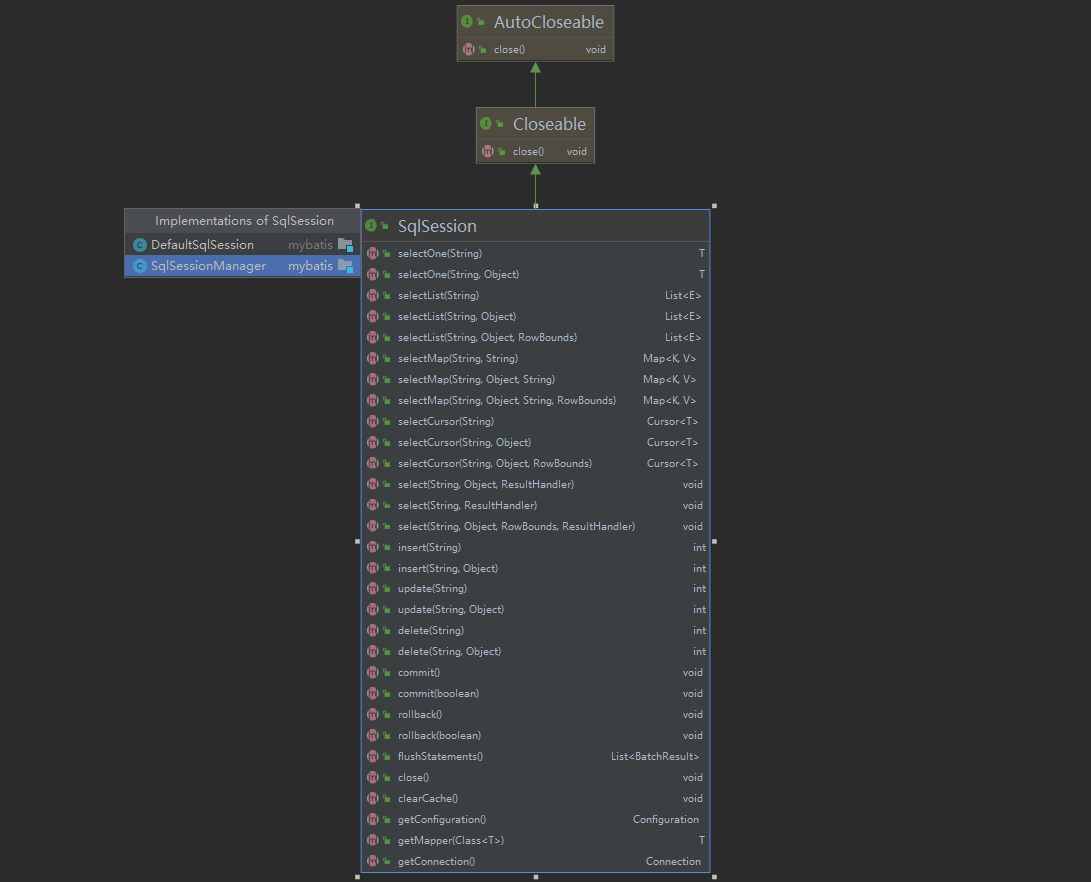
"图2"
SqlSession查询接口嵌套关系
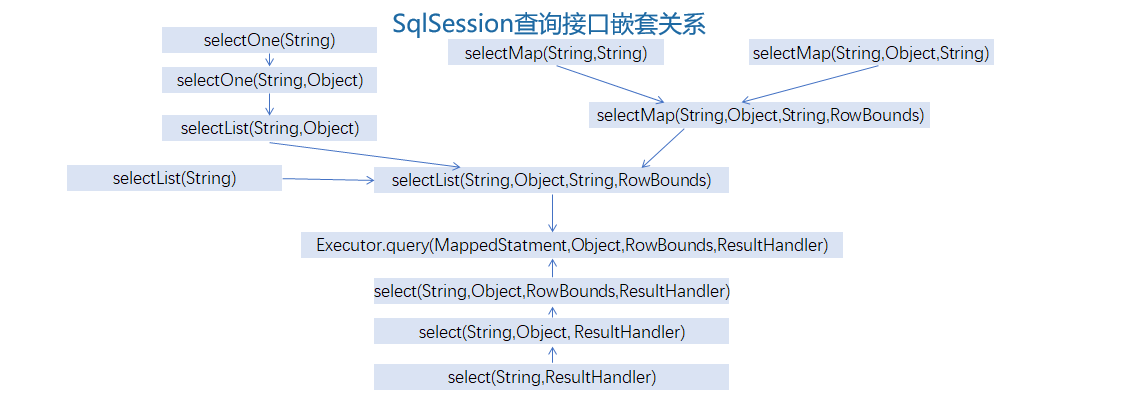
"SqlSession查询接口嵌套关系"
2.SqlSessionFactory
SqlSessionFactory与SqlSession关系UML图
"SqlSessionFactory与SqlSession关系UML图"
SqlSessionFactory 使用工厂模式创建SqlSession,其默认的实现类为DefaultSqlSessionFactory,其中获取SqlSession 的核心方法为openSessionFromDataSource(ExecutorType, TransactionIsolationLevel, boolean),在这个方法中从configuration 中获取的TransactionFactory 是典型的策略模式的应用。运行期,TransactionFactory 接口的实现,是由配置文件配置决定的,可配置选项包括:JDBC、Managed,可根据需求灵活的替换TransactionFactory 的实现。
二、binding 模块分析
0.MyBatis两种编程模型
(1) 使用mapper接口编程,就可以访问数据库;
@Test
// 程序员喜欢的风格
public void quickStart() throws IOException {
// 2.获取sqlSession
SqlSession sqlSession = sqlSessionFactory.openSession();
// 3.获取对应mapper
TUserMapper mapper = sqlSession.getMapper(TUserMapper.class);
// 4.执行查询语句并返回单条数据
TUser user = mapper.selectByPrimaryKey(2);
System.out.println(user);
}(2) 使用sqlsession对外提供数据库的访问;
@Test
// 原始风格,ibatis编程模型 本质分析
public void originalOperation() throws IOException {
// 2.获取sqlSession
SqlSession sqlSession = sqlSessionFactory.openSession();
// 3.执行查询语句并返回结果
TUser user = sqlSession.selectOne("com.taeyeon.mybatis.mapper.TUserMapper.selectByPrimaryKey", 2);
System.out.println(user.toString());
}可以比较以下两种编程风格,发现,直接使用SqlSession 进行数据库开发存在代码可读性差、可维护性差的问题,所以我们很少使用,而是使用Mapper接口的方式进行数据库的开发。实现的基础涉及配置文件的解读以及动态代理的运用。
1.核心类

"图3"
2.运行流程
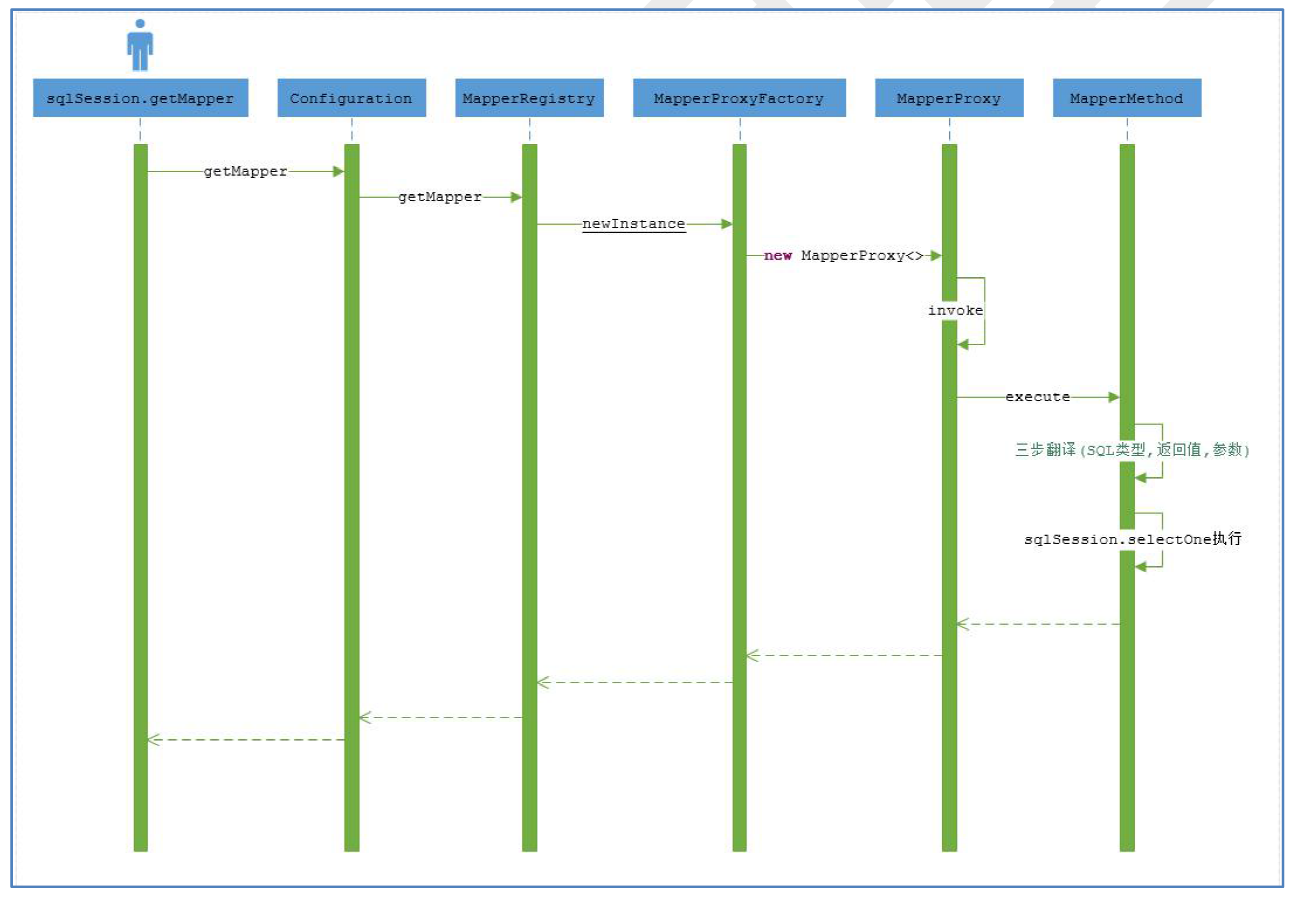
"图4"
三、举个栗子
demo如下:
@Test
// 程序员喜欢的风格
public void quickStart() throws IOException {
// 2.获取sqlSession
SqlSession sqlSession = sqlSessionFactory.openSession();
// 3.获取对应mapper
TUserMapper mapper = sqlSession.getMapper(TUserMapper.class);
// 4.执行查询语句并返回单条数据
TUser user = mapper.selectByPrimaryKey(2);
System.out.println(user);
}1.打开一个会话
SqlSession sqlSession = sqlSessionFactory.openSession();2.DefaultSqlSessionFactory
有两个实现类,主要看DefaultSqlSessionFactory.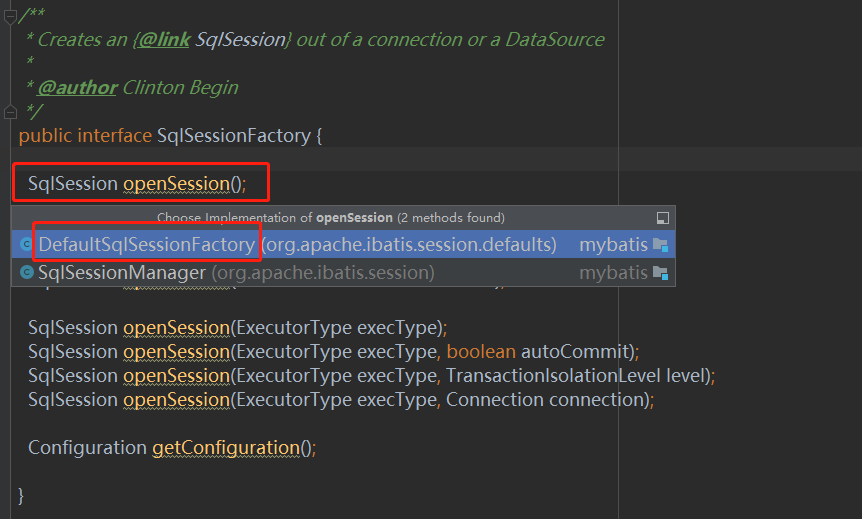
"图5"
点进去看看openSession的方法内容
@Override
public SqlSession openSession() {
return openSessionFromDataSource(configuration.getDefaultExecutorType(), null, false);
}关键瞧瞧openSessionFromDataSource这个方法干了什么。
/**
* 从数据源获取数据库连接
*
* @param execType 执行类型,ExecutorType主要有三种类型:SIMPLE, REUSE, BATCH,默认是SIMPLE,都在枚举类ExecutorType里面
* @param level 事务隔离级别,都在枚举类TransactionIsolationLevel中定义
* @param autoCommit 是否自动提交,主要是事务提交的设置
* @return SqlSession
*/
private SqlSession openSessionFromDataSource(ExecutorType execType, TransactionIsolationLevel level, boolean autoCommit) {
Transaction tx = null;
try {
//获取mybatis配置文件中的environment对象
final Environment environment = configuration.getEnvironment();
//从environment获取transactionFactory对象
final TransactionFactory transactionFactory = getTransactionFactoryFromEnvironment(environment);
//创建事务对象
tx = transactionFactory.newTransaction(environment.getDataSource(), level, autoCommit);
//根据配置创建executor
final Executor executor = configuration.newExecutor(tx, execType);
//创建DefaultSqlSession
return new DefaultSqlSession(configuration, executor, autoCommit);
} catch (Exception e) {
// may have fetched a connection so lets call close()
closeTransaction(tx);
throw ExceptionFactory.wrapException("Error opening session. Cause: " + e, e);
} finally {
ErrorContext.instance().reset();
}
}重点看看新创建的执行器和DefaultSqlSession。
3.newExecutor
public Executor newExecutor(Transaction transaction, ExecutorType executorType) {
executorType = executorType == null ? defaultExecutorType : executorType;
executorType = executorType == null ? ExecutorType.SIMPLE : executorType;
Executor executor;
//BatchExecutor、SimpleExecutor和CachingExecutor三者之一
if (ExecutorType.BATCH == executorType) {
executor = new BatchExecutor(this, transaction);
} else if (ExecutorType.REUSE == executorType) {
executor = new ReuseExecutor(this, transaction);
} else {
executor = new SimpleExecutor(this, transaction);
}
//如果有<cache>节点,通过装饰器,添加二级缓存的能力
if (cacheEnabled) {
executor = new CachingExecutor(executor);
}
//通过interceptorChain遍历所有的插件为executor增强,添加插件的功能
executor = (Executor) interceptorChain.pluginAll(executor);
return executor;
}4.DefaultSqlSession
再去瞄下DefaultSqlSession干了啥。
public DefaultSqlSession(Configuration configuration, Executor executor, boolean autoCommit) {
this.configuration = configuration;
this.executor = executor;
this.dirty = false;
this.autoCommit = autoCommit;
}DefaultSqlSession实现了SqlSession的方法。

"图6"
当执行以下代码时,调用的其实就是DefaultSqlSession类的selectOne方法(最终调用该类下的selectList方法):
@Override
public <T> T selectOne(String statement, Object parameter) {
// Popular vote was to return null on 0 results and throw exception on too many.
List<T> list = this.<T>selectList(statement, parameter);
if (list.size() == 1) {
return list.get(0);
} else if (list.size() > 1) {
throw new TooManyResultsException("Expected one result (or null) to be returned by selectOne(), but found: " + list.size());
} else {
return null;
}
}
@Override
public <E> List<E> selectList(String statement, Object parameter, RowBounds rowBounds) {
try {
//从configuration中获取要执行的sql语句的配置信息
MappedStatement ms = configuration.getMappedStatement(statement);
//通过executor执行语句,并返回指定的结果集
return executor.query(ms, wrapCollection(parameter), rowBounds, Executor.NO_RESULT_HANDLER);
} catch (Exception e) {
throw ExceptionFactory.wrapException("Error querying database. Cause: " + e, e);
} finally {
ErrorContext.instance().reset();
}
}5.Executor
先大致了解下Executor的类继承关系。
"图7"
所以,我们重点看看这段代码的奥秘。
return executor.query(ms, wrapCollection(parameter), rowBounds, Executor.NO_RESULT_HANDLER);先看BaseExecutor.
@Override
public <E> List<E> query(MappedStatement ms, Object parameter, RowBounds rowBounds, ResultHandler resultHandler) throws SQLException {
//获取sql语句信息,包括占位符,参数等信息
BoundSql boundSql = ms.getBoundSql(parameter);
//拼装缓存的key值,这里后续讲讲key的生成规则
CacheKey key = createCacheKey(ms, parameter, rowBounds, boundSql);
return query(ms, parameter, rowBounds, resultHandler, key, boundSql);
}
@SuppressWarnings("unchecked")
@Override
public <E> List<E> query(MappedStatement ms, Object parameter, RowBounds rowBounds, ResultHandler resultHandler, CacheKey key, BoundSql boundSql) throws SQLException {
ErrorContext.instance().resource(ms.getResource()).activity("executing a query").object(ms.getId());
if (closed) {//检查当前executor是否关闭
throw new ExecutorException("Executor was closed.");
}
if (queryStack == 0 && ms.isFlushCacheRequired()) {//非嵌套查询,并且FlushCache配置为true,则需要清空一级缓存
clearLocalCache();
}
List<E> list;
try {
queryStack++;//查询层次加一
list = resultHandler == null ? (List<E>) localCache.getObject(key) : null;//查询以及缓存
if (list != null) {
//针对调用存储过程的结果处理
handleLocallyCachedOutputParameters(ms, key, parameter, boundSql);
} else {
//缓存未命中,从数据库加载数据
list = queryFromDatabase(ms, parameter, rowBounds, resultHandler, key, boundSql);
}
} finally {
queryStack--;
}
if (queryStack == 0) {
for (DeferredLoad deferredLoad : deferredLoads) {//延迟加载处理
deferredLoad.load();
}
// issue #601
deferredLoads.clear();
if (configuration.getLocalCacheScope() == LocalCacheScope.STATEMENT) {//如果当前sql的一级缓存配置为STATEMENT,查询完既清空一集缓存
// issue #482
clearLocalCache();
}
}
return list;
}我们先看缓存未命中的部分,即queryFromDatabase方法。
//真正访问数据库获取结果的方法
private <E> List<E> queryFromDatabase(MappedStatement ms, Object parameter, RowBounds rowBounds, ResultHandler resultHandler, CacheKey key, BoundSql boundSql) throws SQLException {
List<E> list;
localCache.putObject(key, EXECUTION_PLACEHOLDER);//在缓存中添加占位符
try {
//调用抽象方法doQuery,方法查询数据库并返回结果,可选的实现包括:simple、reuse、batch
list = doQuery(ms, parameter, rowBounds, resultHandler, boundSql);
} finally {
localCache.removeObject(key);//在缓存中删除占位符
}
localCache.putObject(key, list);//将真正的结果对象添加到一级缓存
if (ms.getStatementType() == StatementType.CALLABLE) {//如果是调用存储过程
localOutputParameterCache.putObject(key, parameter);//缓存输出类型结果参数
}
return list;
}其最终调用SimpleExecutor的doQuery方法。
@Override
//查询的实现
public <E> List<E> doQuery(MappedStatement ms, Object parameter, RowBounds rowBounds, ResultHandler resultHandler, BoundSql boundSql) throws SQLException {
Statement stmt = null;
try {
//获取configuration对象
Configuration configuration = ms.getConfiguration();
//创建StatementHandler对象,
StatementHandler handler = configuration.newStatementHandler(wrapper, ms, parameter, rowBounds, resultHandler, boundSql);
//StatementHandler对象创建stmt,并使用parameterHandler对占位符进行处理
stmt = prepareStatement(handler, ms.getStatementLog());
//通过statementHandler对象调用ResultSetHandler将结果集转化为指定对象返回
return handler.<E>query(stmt, resultHandler);
} finally {
closeStatement(stmt);
}
}看看doQuery方法的内部执行步骤:
(1)获取配置信息对象。
(2)通过配置对象获取一个新的StatementHandler,该类主要用来处理一次SQL操作。
(3)预处理StatementHandler对象,得到Statement对象。
(4)传入Statement和结果处理对象,通过StatementHandler的query方法来执行SQL,并对执行结果进行处理。
先看看newStatementHandler干了啥。
public StatementHandler newStatementHandler(Executor executor, MappedStatement mappedStatement, Object parameterObject, RowBounds rowBounds, ResultHandler resultHandler, BoundSql boundSql) {
//创建RoutingStatementHandler对象,实际由statmentType来指定真实的StatementHandler来实现
StatementHandler statementHandler = new RoutingStatementHandler(executor, mappedStatement, parameterObject, rowBounds, resultHandler, boundSql);
//加入插件
statementHandler = (StatementHandler) interceptorChain.pluginAll(statementHandler);
return statementHandler;
}瞧瞧StatementHandler的小弟们。
"图8"
总结下StatementHandler是干啥的,以及它的小弟们分别能干啥。
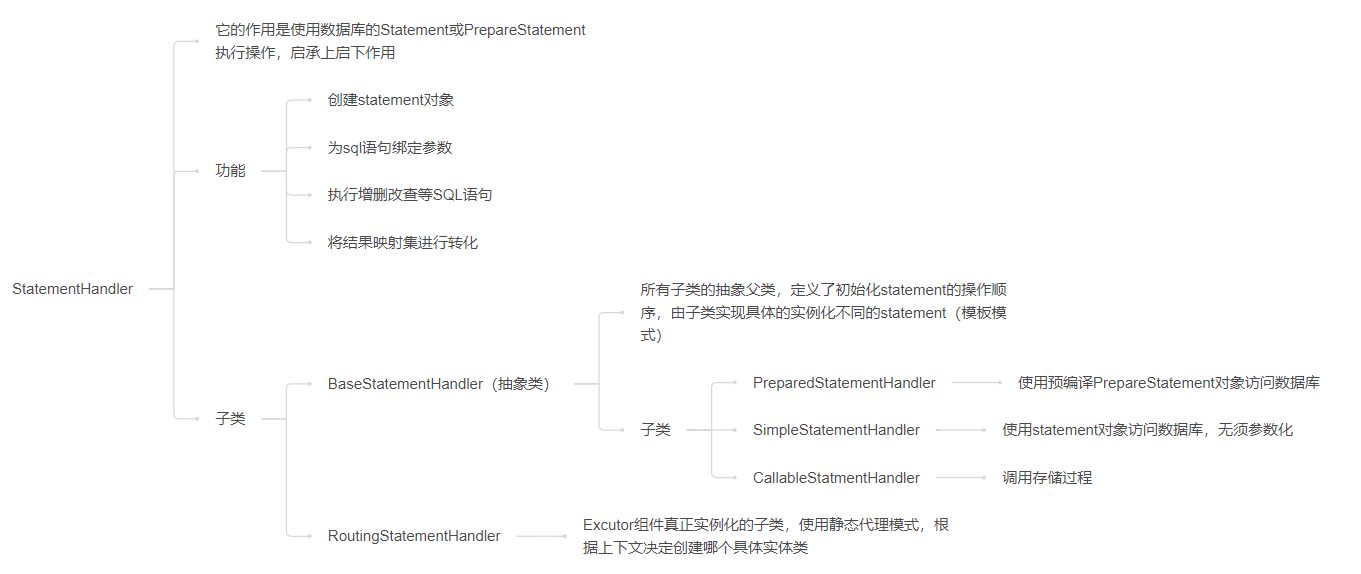
"图9"
再看看prepare干了啥。
stmt = handler.prepare(connection, transaction.getTimeout());主要是BaseStatementHandler干活儿.
@Override
//使用模板模式,定义了获取Statement的步骤,其子类实现实例化Statement的具体的方式;
public Statement prepare(Connection connection, Integer transactionTimeout) throws SQLException {
ErrorContext.instance().sql(boundSql.getSql());
Statement statement = null;
try {
//通过不同的子类实例化不同的Statement,分为三类:simple(statement)、prepare(prepareStatement)、callable(CallableStatementHandler)
statement = instantiateStatement(connection);
//设置超时时间
setStatementTimeout(statement, transactionTimeout);
//设置数据集大小
setFetchSize(statement);
return statement;
} catch (SQLException e) {
closeStatement(statement);
throw e;
} catch (Exception e) {
closeStatement(statement);
throw new ExecutorException("Error preparing statement. Cause: " + e, e);
}
}最后执行query方法
handler.<E>query(stmt, resultHandler);获得结果集。(这里面有结果集的处理,后续再讲。)


